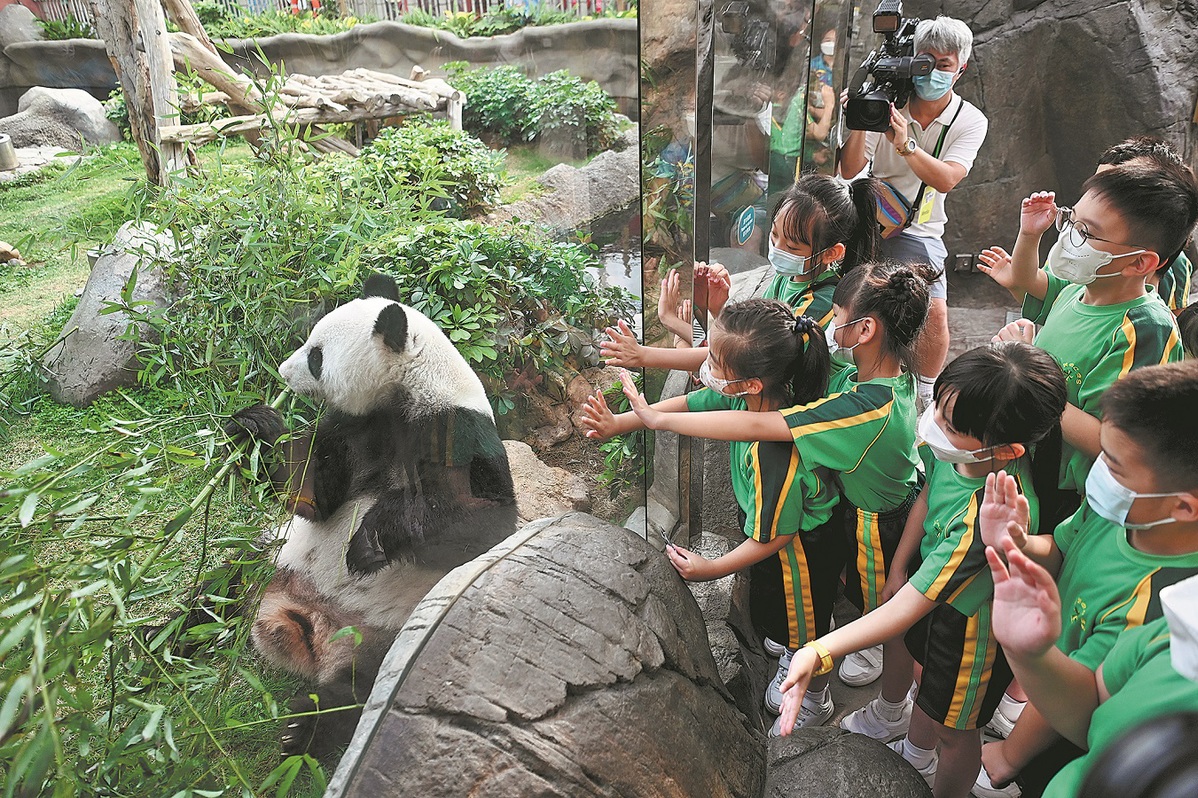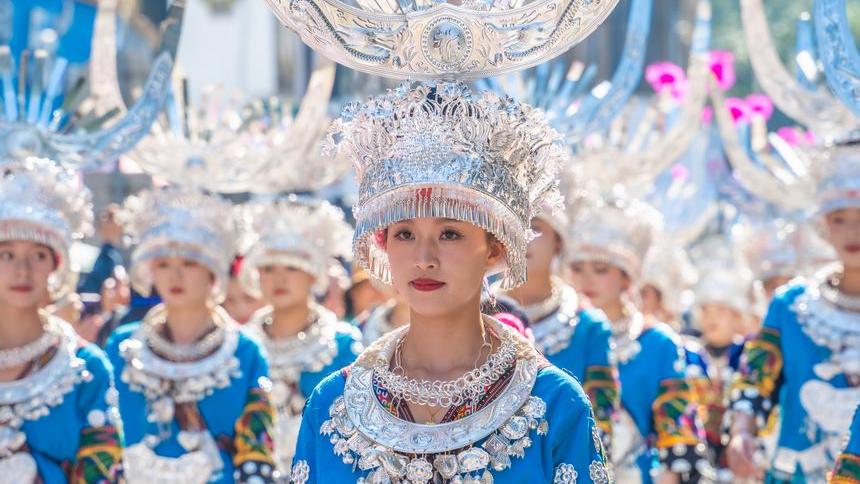Birth of panda twins brings double joy

Students greet giant panda Ying Ying at Ocean Park in Hong Kong in 2022. (LI ZHIHUA/CHINA NEWS SERVICE)
If anyone is happy about giant panda Ying Ying successfully giving birth to twin cubs in August after years of futile mating attempts and a miscarriage, it's Janet Long Shun-kwan.
Long began looking after Ying Ying in 2009, and was close by during the giant panda's decade-long efforts to give birth, which started in 2011.
Ying Ying and male panda Le Le were gifted by the central government to Hong Kong in 2007, but several mating attempts had failed to produce cubs.
In 2015, Long accompanied Ying Ying to the Wolong Shenshuping Base of the China Conservation and Research Center for the Giant Panda in southwest Sichuan province, where the giant panda was to take part in a natural breeding program.
Long and Ying Ying stayed at the base for six months. The giant panda was able to conceive, but miscarried.
However, the trip was romantically fortuitous for Long. At the base, she met Dong Chao, a senior caretaker involved in giant panda breeding since 2003, who later became her husband.
Long returned to Hong Kong, but the budding romance with Dong grew stronger, with their shared passion for giant pandas bringing them closer together.
In 2018, Long, after much soul searching, resigned from her job in Hong Kong and moved to Wolong to start a family with Dong.

Giant panda Ying Ying at Ocean Park in Hong Kong in September, 2022. (LI ZHIHUA/CHINA NEWS SERVICE)
Close connections
The marriage of Long and Dong, thanks in no small part to Ying Ying, embodies the strong bonds between Hong Kong and Sichuan developed through panda connections.
Before Ying Ying and Le Le's arrival, the central government sent the first pair of pandas — An An and Jia Jia — to the city in 1999 to mark the two-year anniversary of Hong Kong's return to the motherland.
The 8.0 magnitude earthquake that struck Wenchuan region of Sichuan on May 12, 2008, also brought Hong Kong and the province closer together.
The quake severely damaged the Wolong National Nature Reserve, located less than 20 kilometers from the epicenter of the temblor in Yingxiu town.
He Yongguo, director of the Shenshuping Base in Wolong, recalled that the base was almost completely destroyed. Most of the animal enclosures had collapsed, the giant pandas were extremely frightened, and all roads connecting to the outside world were cut off.
In no time, Hong Kong raced to provide aid to reconstruct Wenchuan, including the heavily-damaged Shenshuping Base. The Hong Kong Special Administrative Region government provided HK$10 billion ($1.28 billion) for 190 projects over eight years. A total of 151 projects were handled by the HKSAR government, and 32 by nongovernmental organizations.
Twenty-three of the reconstruction projects were in the Wolong National Nature Reserve. The flagship projects were Dujiangyan Base and Shenshuping Base — the two panda bases of the China Conservation and Research Center for the Giant Panda. The reconstruction efforts were jointly headed by seven well-established architects from Hong Kong and the Chinese mainland. The reconstructed bases received the highest three-star rating from the China Green Building Label system, and became important facilities for international panda conservation and research exchanges.
Vital breeding base
The rebuilt Shenshuping Base is the world's largest giant panda breeding, rearing, and research base.
It is also the only training center in the world for the reintroduction of pandas into the wild.
The base covers an area of about 150 hectares, and has 30 panda habitats, a panda hospital, labs, and a science education center. Hong Kong committed just over 226 million yuan ($31.28 million) to the project.
In recognition of Hong Kong's contribution, when the two bases reopened in May 2016, they announced that all of the city's residents could enter free of charge with their ID cards.
However, He, who witnessed the entire reconstruction process, said the support from Hong Kong was more than just material. Hong Kong contributors also helped locals repair their mental state, by organizing community meetings and exchanges.
This played a role in promoting the economic recovery of the region and also advanced the sustainable development of Wolong district, he added.
Hong Kong's Ocean Park had a significant role in the reconstruction of Wolong. The theme park's conservation arm, The Ocean Park Conservation Foundation, established the Giant Panda Base Rebuilding Fund, which offered financial support for recovery work at 12 panda reserves in Sichuan.
Paulo Pong Kin-yee, chairman of the Ocean Park Corporation, said in a recent interview with China Daily, that the birth of Ying Ying's twin cubs was a further testament to the collaboration between teams in Sichuan and Hong Kong.
When Ying Ying began showing signs she was ready to give birth in late July, the giant panda center in Sichuan promptly arranged for breeding expert Dong Li and cub-rearing expert Zhang Yahui to travel to Hong Kong.
With the support of the park's animal care team and the center's experts, Ying Ying gave birth to the panda cubs on Aug 15, after a difficult five-hour labor.
Pong said that the park has always maintained a close partnership with Sichuan on panda breeding and conservation. Experts from the giant panda center visited Hong Kong around March each year, during the giant panda mating season — to check on Ying Ying's condition and share panda breeding knowledge with the park's caretakers.
Prime opportunity
With the arrival of the twins, Ocean Park now has six pandas, which Pong described as "unprecedented" and a major drawcard to bring in large crowds, especially overseas tourists.
The stories behind the giant pandas can also attract more foreign visitors to Hong Kong, and showcase the city's and country's latest developments in ecological protection, Pong added.
Meng Ying, an associate professor at Guangming School of Journalism and Communication at China University of Political Science and Law, suggested that Ocean Park should start posting short videos about the giant pandas to capture greater public attention.
Following that, livestreams, which are more interactive and require higher audience engagement, could help deepen affection for the creatures and enable broader dissemination of content, she said. Meng said Hong Kong's media could also serve up content on the animals that is suitable for a global audience.
The most important aspect, however, is to focus on the "undisturbed and natural" daily lives of the pandas, she said. This includes disclosing interesting details about the animals, such as how the keepers prepare their food. These details can transcend different cultures and be appreciated and loved by international audiences, she said.
A good way to drive home the message of China's giant panda conservation efforts would be by giving full play to the idea of "family bonds", with Hong Kong having six pandas living in Ocean Park, Meng said.
Animal conservation is a universal language that could draw an international audience, she said.
Anthony Fung Ying-him, professor of the Chinese University of Hong Kong's Journalism and Communication School, said the natural resources of Hong Kong Island's southern district — where the park is located, could be leveraged to create green tourism projects. Such projects could integrate conservation content about giant pandas and other animals at Ocean Park.
The recent birth of the cubs also offers an opportunity to present immersive internet content about their growth, and convey conservation concepts to a broader audience, especially young people, Fung said.
Advanced technologies like virtual reality, for instance, could showcase their natural habitats, living habits, reproductive processes, and survival challenges. This not only generates economic benefits, but also raises public awareness about the importance of the natural environment and the need for wildlife protection.
Pong said Ocean Park is considering livestreaming and is in contact with various domestic and international organizations.
However, the primary consideration for livestreams and other social media is ensuring that they do not affect the giant pandas' health and quality of life. The park will not be swayed by online attention and traffic in this regard, Pong said.
Improving understanding
Shenshuping Panda Base said protection of the giant pandas is the primary goal, rather than using them for entertainment value.
He, the base director, said its primary aim is to promote scientific understanding through various channels — such as official media and popular science videos — to enhance the public's understanding of giant pandas and the conservation efforts surrounding them.
Having worked in panda-related fields for many years, He said he is pleased to see ardent fans of the animals become ambassadors for them by voluntarily disseminating knowledge. These supporters are deeply engaged in the panda online community and the giant panda base, and help correct misunderstandings about the animal, He added.
The iPanda channel, China's first giant panda livestreaming platform, has more than 100 fixed cameras that showcase the daily lives of giant pandas around the clock.
Launched in August 2013, the channel quickly built an online panda community, amassing over 56 million active users worldwide including in Germany, Spain, France, Russia and Japan.
Guo Yanan, deputy director of iPanda, credited the success of the channel to the media operations team and the giant panda caretaker team, which have been involved since the channel's inception.
The team has established detailed guidelines that must be followed when installing livestreaming cameras in panda enclosures. For example, power cables and network cables must be positioned carefully to ensure there are no safety risks to the pandas.
The placement angles of the cameras also need to be adjusted regularly, given the varying conditions at each base.
Hong Kong's new giant panda twins are expected to meet the public in the first quarter of next year when they will be about six months old, Ocean Park caretakers said.
The two have not been officially named yet, but the female cub, is nicknamed Gaje, "elder sister" in Cantonese, and the male Sailou, or "little brother".
The birth of the twins has cemented the strong bonds between Hong Kong and Sichuan, which are expected to grow and strengthen along with the two cubs.
Photos
Related Stories
Copyright © 2024 People's Daily Online. All Rights Reserved.









